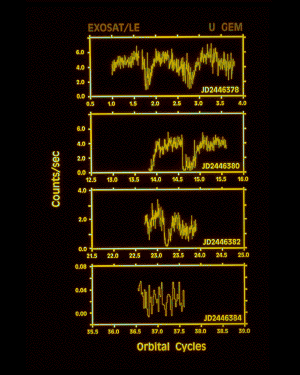EXOSAT light curves of U Gem
The soft X-ray intensity of the cataclysmic variable U Gem during the late part of a long outburst seen in 1985. The orbital period is clearly indicated by the variable profile dips. These are caused by absorption of the soft X-rays in gas which splashes out of the orbital plane at the point where the accretion stream from the secondary star hits the accretion disc. By the third observation the main dip has become very broad and a narrow dip half an orbital period away has developed.
IMAGES |
By Mission |
Stars |
HEASARC Home | Observatories | Archive | Calibration | Software | Tools | Students/Teachers/Public Last modified: Thursday, 26-Jun-2003 13:48:44 EDT HEASARC Staff Scientist Position - Applications are now being accepted for a Staff Scientist with significant experience and interest in the technical aspects of astrophysics research, to work in the High Energy Astrophysics Science Archive Research Center (HEASARC) at NASA Goddard Space Flight Center (GSFC) in Greenbelt, MD. Refer to the AAS Job register for full details. |


